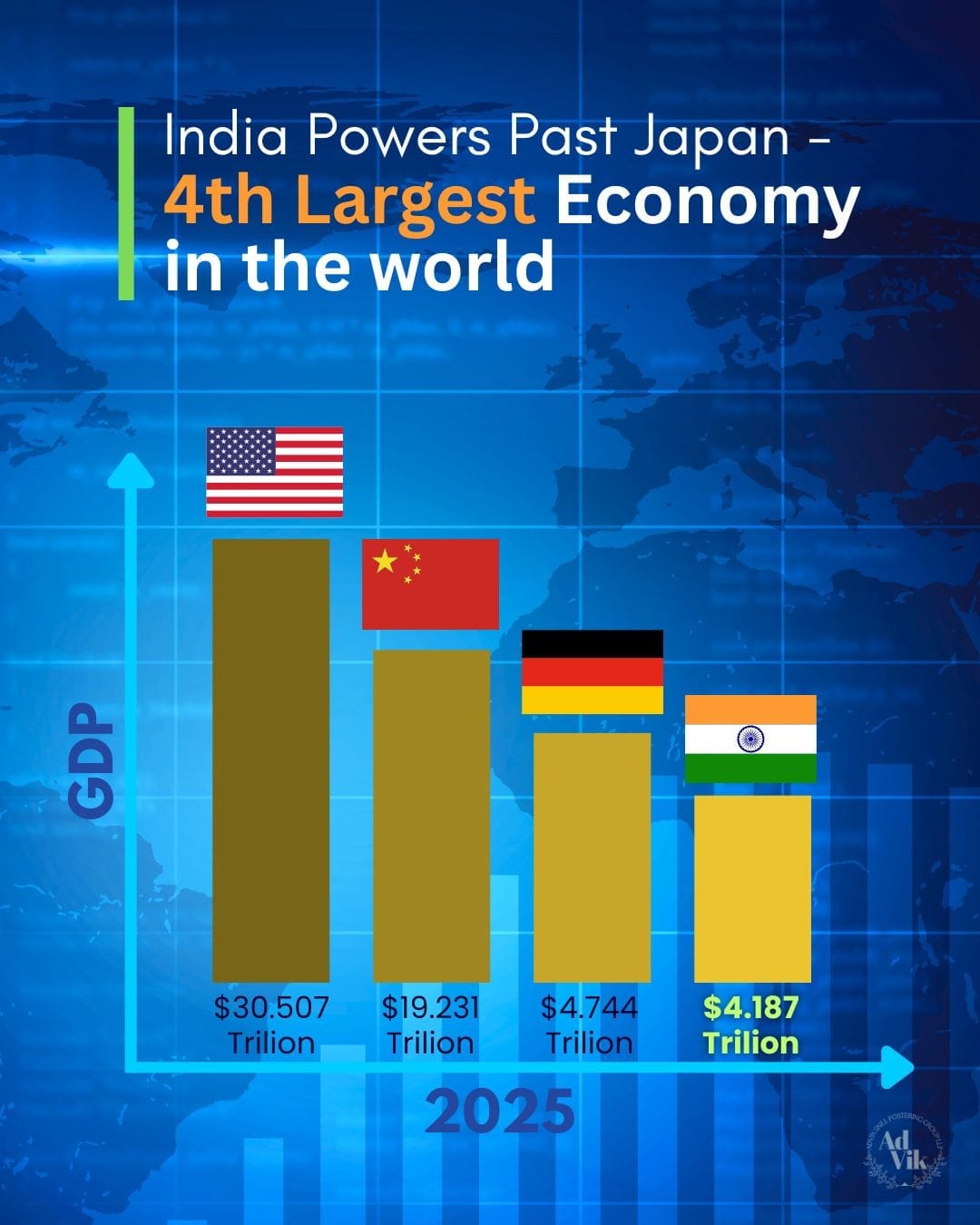
In a moment that marks a turning point in global economics, India has officially overtaken Japan to become the world’s fourth-largest economy by nominal GDP — now trailing only the United States, China, and Germany.
It’s a headline that fuels national pride and ignites global curiosity.
But once the initial celebration quiets down, a deeper question arises:
Is this number enough? Or is it just the beginning of a much longer journey?
Let’s dig into what this truly means for India, its people, and its future.
What Is Nominal GDP — and Why Does It Matter?
Nominal GDP is the total value of all goods and services produced within a country, calculated at current market prices — without adjusting for inflation.
In simple terms:
It reflects the sheer monetary size of an economy.
So when India overtakes Japan in nominal GDP, it means India’s economic output, in dollar terms, is now larger than Japan’s.
📦 Think of it like this:
If every country had a bucket of water representing its economy, India’s bucket just got heavier than Japan’s.
But here’s the twist: size isn’t everything.
PPP vs. Nominal GDP — Two Sides of the Economic Coin
While Nominal GDP is based on market exchange rates, Purchasing Power Parity (PPP) adjusts for local cost of living and inflation, revealing what money can actually buy within a country.
💵 $100 in Tokyo ≠ $100 in Mumbai
Under PPP, India had already surpassed Japan years ago. In fact, India is currently the third-largest economy globally in PPP terms — behind only China and the U.S.
But here’s the catch:
PPP doesn’t make headlines. Nominal GDP does.
The Bigger Picture: Per Capita Income
Let’s zoom in.
India has a population of over 1.4 billion, while Japan has just 124 million.
So when we divide the GDP by the number of people:
- Japan’s Per Capita Income (Nominal): ~$33,000
- India’s Per Capita Income (Nominal): ~$2,700
Despite having a larger economy, the average Indian earns over 10x less than the average Japanese citizen.
In other words: India’s GDP rise hasn’t yet translated into equal prosperity.
Growth vs. Development — A Subtle Yet Crucial Divide
India’s achievement is no small feat. It reflects:
- Decades of reform
- Global economic integration
- A thriving services sector
- A young, aspirational population
But GDP is just one metric. True development goes beyond the size of the economy.
It must include:
- ✅ Quality education
- ✅ Accessible healthcare
- ✅ Widespread job creation
- ✅ Income equality
- ✅ Clean energy and smart cities
- ✅ Better infrastructure and sanitation
- ✅ Social equity and justice
Nominal GDP is like a destination sign.
But the condition of the road — and the well-being of the travelers — is what truly matters.
And let’s be honest for a moment:
Despite our ancient civilization and cultural advancements, our civic sense still lags behind.
Even those who know better often don’t practice it. That, too, is part of our developmental journey.
A Philosophical Pause: What Are We Really Chasing?
This is where economics meets ethics.
In the global race of economies, we obsess over scoreboards — but rarely ask:
What is the purpose of this growth?
Who is it really benefitting?
India’s rise is powerful.
But without social justice, education, and dignity for all, it risks being just another number in a spreadsheet.
True development must uplift:
- A farmer in rural Bihar
- A student in Northeast India
- A small-town entrepreneur in Chhattisgarh
- A nurse or sanitation worker in the cities
Until progress reaches every corner, we are not truly developed — just numerically large.
Final Thoughts: A Beginning, Not a Finish Line
India passing Japan in nominal GDP is a symbolic moment — a milestone, not a summit.
It signals that the global order is shifting, and India is rising fast.
But now comes the real challenge:
Not just to be a big economy,
but to be a deeply developed one.
An India where growth is visible not only in statistics,
—but in the lives uplifted.
Because at the end of the day…
GDP may measure the wealth of a nation —
But only well-being measures its wisdom.


